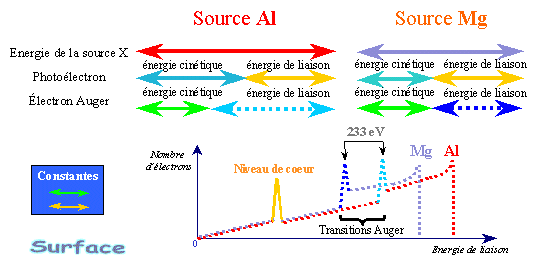 |
  Auger peak shifts Auger peak shifts
To understand this problem, let's take the example of the carbon atom and have a close look to the 1s level. In this atom the binding energy of the 1s electron is 284.6 eV.
If this electron is excited with a magnesium source at 1253.6 eV or aluminium source at 1486.6 eV, it will leave the nucleus with a kinetic energy defined by: E kinetic = hn – E binding. The higher is hn, the higher is the out coming electron kinetic energy - this is the case when we switch from Mg to Al source. The photoelectron kinetic energy is depending on the source nature. Remember that the electron binding energy inside the atom is a physicochemical constant. On the following video sequence, the blue electron orbits around the red nucleus. The aluminium source is sending hn at 1486.6 eV. The electron is pulled out from its orbit and leaves the matter with a kinetic energy calculated by 1486.6 à 284.6, i.e. 1202 eV. This photoelectron loss will cause several Auger transitions (review Auger transition).  In the case of the KLL oxygen Auger transition, the Auger electron is ejected with a constant energy independently of the excitation source. The reason for that is that the Auger electron is generated by the internal atom de-excitation (the atom recovers from a higher energy state caused by the loss of the photoelectron) The Auger electron kinetic energy is always independent from the source nature.  Before continuing be sure to remember that:
Before continuing be sure to remember that:
At first glance it is not easy even for an experienced user to distinguish on a spectrum Auger electron peaks from photoelectron peaks. Changing the source, i.e. changing excitation energy, will cause some peaks to be shifted some peaks not.
Considering a kinetic energy co-ordinate system, we have seen that the Auger electron was leaving the matter with a constant energy regardless of the excitation source energy. On the other hand photoelectrons kinetic energy is depending on the source nature. In XPS, spectra are usually plotted in a "binding energy" co-ordinate system. The below illustration helps understand the Auger line shifts in such a co-ordinate system.  Auger electron : An Auger electron don't have a binding enrgy. It has is own energy. It's a mind view. The orange and green arrows remain constant whichever source is used. The computer calculates the electron binding energy simply by subtracting the kinetic energy from the excitation source energy. Such a difference remains constant for the photoelectron (orange arrow) which implies a fixed core peak in a binding energy co-ordinate system. In the case of Auger electron, the constant kinetic energy causes the subtraction result (blue dashed line arrows) to change accordingly to the source excitation energy. By overlapping Al and Mg source spectra we can see that changing from the Mg to the Al source causes Auger peaks to shift by +233 eV. |